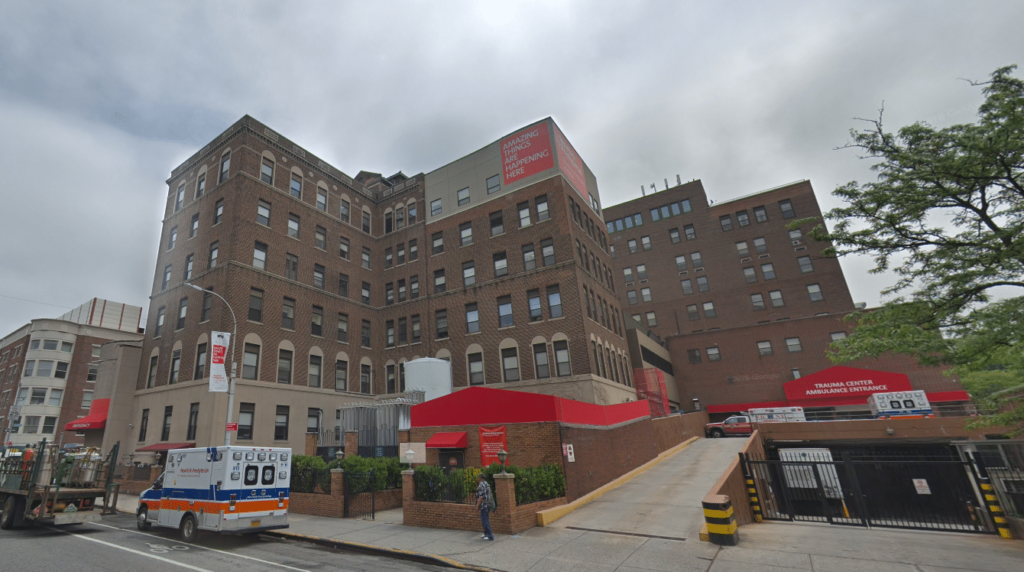NYC Nurses Vote To Ratify Contract For Increased Pay, Safe Staffing Ratios

A majority of union nurses that work at NewYork-Presbyterian hospitals voted Thursday to ratify a four-year contract with the hospital that includes the establishment of minimum staffing ratios among other provisions, according to a Facebook post from the New York State Nurses Association (NYSNA). About 91 percent of the nurses at the hospital voted to ratify the contract agreement, according to the post. NYSNA members and representatives from some of the state’s largest hospitals reached the tentative contract agreement last Tuesday, ending a months-long feud and preventing a major nurse strike. The four-year contract includes a $100 million agreement to hire nearly 1,000 additional staff members at New York-Presbyterian Hospital, Montefiore, and Mount Sinai hospitals, a minimum wage increase of three percent annually and an extended window for nurse retiree health benefits. The provision of the contract praised the most by supporters on social media—and that was often the source of escalating tension between union members and the hospitals—was the agreement to create unit-specific staffing grids that would establish minimum nurse-to-patient ratios. This is the first time minimum staffing levels have been “spelled out in the contract with a meaningful enforcement mechanism,” according to a press release from NYSNA. Once both parties agree on the minimum staffing levels, a third-party arbitrator will be responsible for enforcing those levels and changing them based on patient census and acuity changes, according to the contract. Anthony Ciampa, first vice president of the New York State Nurses Association told the New York Times this agreement marks a groundbreaking achievement in addressing staffing issues statewide. “This is going to have a very positive impact, and it will be the trendsetter of the industry,” Ciampa told New York Times. “What we decide in these major city hospitals tends to set the framework for other hospitals.” Details of the full agreement can be view below:
Question 1: Massachusetts Nurse-To-Patient Ratio Ballot Initiative Defeated

Massachusetts’ Question 1, a ballot initiative that would have established mandatory nurse-patient ratios in hospitals was defeated during the general election Tuesday. The Massachusetts Nurses Association, a union representing nurses in 51 acute care hospitals across the state, conceded defeat around 9 p.m. Tuesday evening. At approximately 10:20 p.m., the initiative had 969,400 votes against and 416,720 votes in favor, with more than 50 of precincts reporting, according to the preliminary results. “We are all disappointed by tonight’s results and the impact this will have on the patients we care for every day,” MNA President Donna Kelly-Williams said in prepared remarks. “We know that right now – as I speak to you here – there are nurses caring for too many patients and those patients are unnecessarily being put in harm’s way. And the problem continues to grow every year. The status quo is not a solution here.” The outcome was a victory for the Massachusetts Health and Hospital Association, who opposed the initiative for fear that it would dramatically increase state healthcare costs. The association represents 70 hospitals across the state. “This is the beginning of a conversation, not the end,” MHA President and CEO Steve Walsh said in a statement to Mass Live. “Question 1 forced some difficult and necessary discussions about the future of healthcare and the future of our workforce going forward. These conversations with our care teams and in our communities have been critically important and will continue in bargaining sessions, legislative debates, board rooms and newspapers.” An independent study conducted by the state’s Health Policy Commission found that implementing the mandate would cost an estimated $676-949 million per year and potentially save $34-47 million. The study also found that hospitals would need to hire 2,286 to 3,101 additional full-time equivalent nurses to meet the mandate.
Massachusetts Voters Split On Mandated Nurse Staffing

With only two weeks left until the Nov. 6 midterm election, Massachusetts voters are split evenly on establishing statewide mandated nurse-to-patient ratios, according to a new poll by WBUR, Boston’s NPR news station. Of the 506 Massachusetts residents surveyed, 44 percent were in favor of mandated nurse staffing, and 44 percent were opposed. The remaining 12 percent said they were undecided. Advocates for the mandate, also known as Question 1, have said establishing mandated nurse staffing ratios will lead to better patient outcomes and improve quality of care. Opponents have said the opposite and also claim mandated ratios will put an expensive burden on state hospitals. Both sides claim nurses fully support them. Both groups have spent a combined total of more than $14 million on competing TV advertisements and campaign initiatives. Because both groups have run similar ad campaigns, voters have had a difficult time figuring out how nurses actually feel about the issue, according to the WBUR report. The pro-mandate group, the Committee to Ensure Safe Patient Care, is sponsored by the Massachusetts Nurses Association. Most of the group’s supporters are nursing unions, labor unions, international labor unions and local community groups, according to their website. The group also earned key endorsements from several local, state and federal representatives, most notably Sen. Elizabeth Warren and Boston Mayor Martin J. Walsh. “Nurses work hard to take care of all of us when it matters the most, and we should do the same for them by establishing standards to ensure they have the help they need to do their job safely,” Senator Warren said in a press release. “I stand with our nurses and support a yes vote on Question 1 in November.” The opposing group, known as the Coalition to Protect Patient Safety, is supported mostly by hospitals, hospitals associations and local chambers of commerce, according to their website. The organization has also earned a handful of endorsements from local mayors, including Waltham Mayor Jeanette McCarthy. An independent study conducted by the state’s Health Policy Commission found that implementing the mandate would cost an estimated $676-949 million per year and potentially save $34-47 million. The study also found that hospitals would need to hire 2,286 to 3,101 additional full-time equivalent nurses to meet the mandate. You can read the full analysis of the study below:
Mass. Nurses Argue Pros, Cons of Mandated Ratios In Ads For Ballot Initiative

Already know all about Question 1 in Massachusetts? Click here to read about how this could impact travel nursing in the state. Massachusetts nurses are arguing on both sides of the fence in the first wave of TV advertisements about a ballot initiative that would regulate nurse staffing ratios in the state, according to a Boston Globe report. The Massachusetts Nurses Association, which sponsored the initiative, supports the Committee to Ensure Safe Patient Care along with many other local labor unions both in and out of the state. The committee argues that safe staffing ratios in non-ICU units will cut down on patient complications, readmissions, errors and potentially life-threatening risks. The Coalition To Protect Patient Safety, an anti-initiative group backed by state hospital groups and local chambers of commerce, argue that adopting a rigid proposal will “take decision-making power out of the hands of healthcare professionals” and negatively impact hospital costs and quality of care. While both groups stances on Question 1 are clearly opposed, their similar advertising and marketing strategies could cause confusion for uninformed voters, according to the Globe report. Both groups have similar names, use nurse testimonials in their website advertisements, feature similarly designed lawn signs and even have nearly identical Twitter handles. (Pro-initiative @PatientSafetyMA and anti-initiative @MAPatientSafety) Both groups are ramping up advertising efforts ahead of the Nov. 6 midterm elections. If approved by voters, the initiative would establish patient limits determined by the type of medical unit or patient with whom a nurse is working, and the limit would be applied at all times, according to the Massachusetts Secretary of State website. Civil penalties for hospitals that don’t comply with the mandated ratios could go up to $25,000 per violation, along with $250-2,500 in fines per day for facilities that don’t have information about the limits in all patient rooms, units and patient areas. How “Yes” On Question 1 Could Affect Travelers In short, mandated nurse-to-patient ratios across the state could sharply increase nurse recruiting and retention efforts by hospitals, which in turn could increase the amount of travel nurse needs. While multiple states have laws relating to nurse staffing ratios, only California has both passed and implemented mandatory statewide ratios. The state passed the law in 1999, implemented it completely by 2004, and since then has been the source of numerous studies about the impact of mandated ratios. Most studies found positive benefits for patient outcomes, significantly lower mortality rates and reduced nurse burnout, but several also point to greatly increased staffing efforts leading up to and after implementation. A 2008 study submitted to the Journal of Hospital Medicine found that nurse staffing in California remained unchanged from 1993 to 1999, but facilities significantly increased staffing efforts between 1999 and 2004. As of 2017, the state had the highest number of registered nurses in the U.S. at 282,290, according to Bureau of Labor Statistics data. It also holds the top spot for the number of active nursing licenses with more than 432,000 as of Sept. 8, according to National Council of State Boards of Nursing data. There are other factors to consider when determining why California brings in so many nurses—geographic diversity, lots of rural communities, high paying contracts—but many staff and travel nurses cite mandated ratios as a positive benefit of working in the state, which could help with hospital recruiting.
#NursesTakeDC movement closes on third year, continues push for safe nurse-patient ratios

For the third consecutive year, hundreds of nurses took to the lawn of the U.S. Capitol building this week as part of the #NursesTakeDC movement, whose goal is to raise public awareness of unsafe nurse-patient ratios and push legislation to regulate the issue. I’m rallying with #nursestakedc today in front of the Capitol to demand safe staffing ratios. Safe staffing saves lives. pic.twitter.com/yNvDjDZuJG — Jan Schakowsky (@janschakowsky) April 26, 2018 The grassroots movement has grown each year in both the number of speakers in the industry and number of attendees who support it. The movement’s goal is to combat unsafe staffing practices at hospitals, which contributes to nursing burnout, lower quality patient care and a higher risk of patient death, according to the Nurses Take DC website. Several studies have gone into the impact of high nursing-patient ratios over the years. One of the most recently published on the National Center for Biotechnology Information looking at ICU patient ratios found that “exposing critically ill patients to high workload/staffing ratios is associated with a substantial reduction in the odds of survival.” A major goal of the campaign is to lean on federal legislators to move forward with the Nurse Staffing Standards and Quality Care Act of 2017 (S. 1063 and H.R. 2392), which would amend the Public Health Service Act to establish safe nurse-patient staffing ratios across all hospitals, according to their website. Did you know @SenSanders @BernieSanders is a sponsor of safe staffing levels!? We need more sponsors…how about @SenBooker & @SenatorMenendez ?? #S1063 #safestaffing @nursestakedc https://t.co/d9G9tmjGZZ — HPAE (@hpaeaft) April 26, 2018 The bill is modeled after similar legislation for ICU nurses in California and Massachusetts, which are currently the only states with established laws limiting nurse-patient ratios. Along with establishing minimum ratios, the bill would protect “whistleblowers” who speak out against unsafe staffing conditions from being terminated, according to a press release. @SenSherrodBrown @SenWarren @SenSanders @janschakowsky @RepGutierrez @RepBobbyRush @RepMikeQuigley @keithellison @RepYvetteClarke Come out Thursday 4/26 Permit Area 1, west side of Capitol, to meet thousands of nurses. pic.twitter.com/bLaosNTf1u — Doris BSN RN-BC CCRC (@DorisCarrollRN) April 21, 2018 The bill was introduced in 2017 during the last #NursesTakeDC rally on May 5 but stalled quickly after being introduced in the House and Senate. Part of the movement’s strategies this year was to educate nurses on how to effectively lobby legislators about the issue. If you would like to learn more about the Nurses Take DC movement, visit NursesTakeDC.com #NursesTakeDC Tweets
